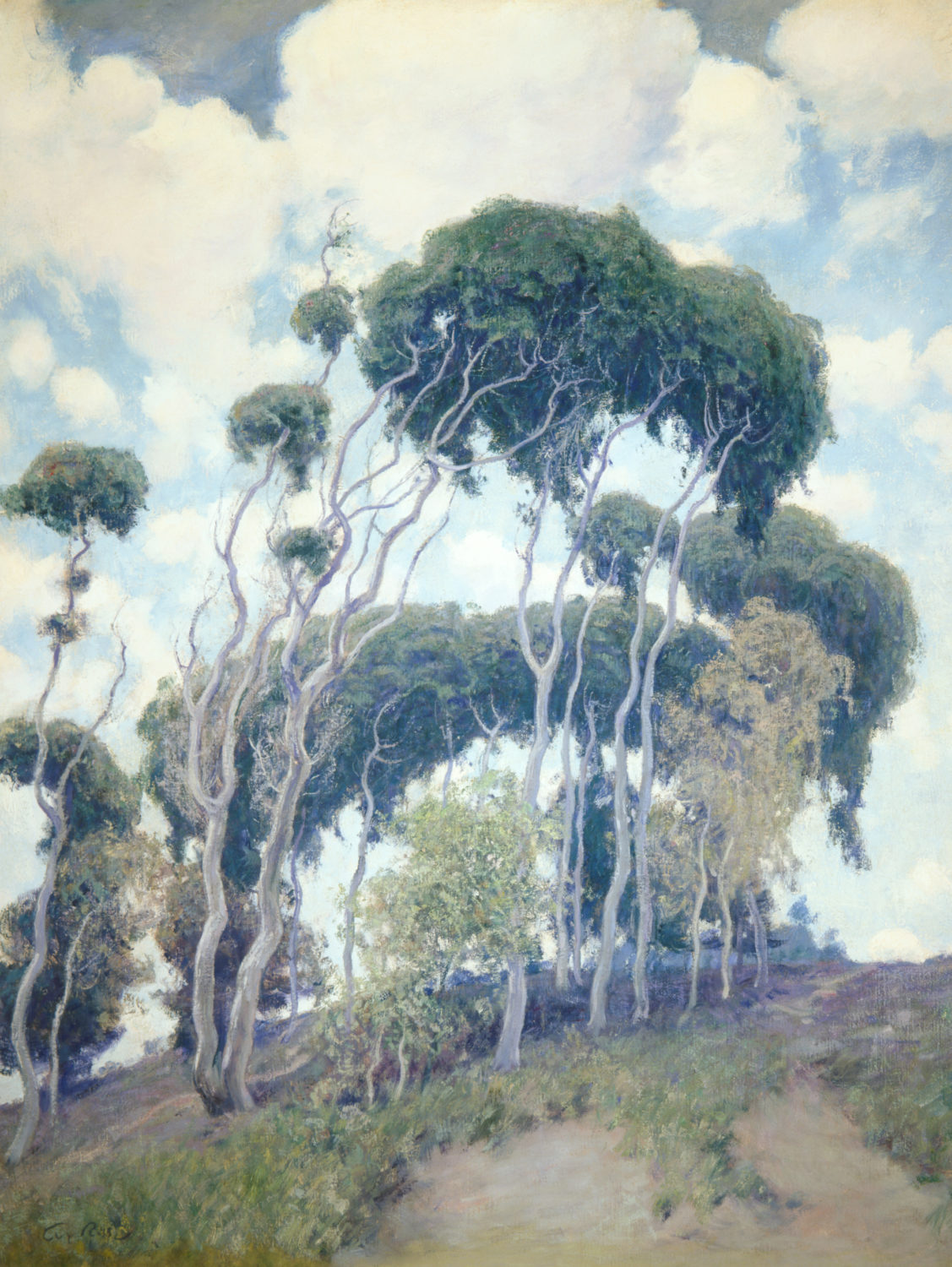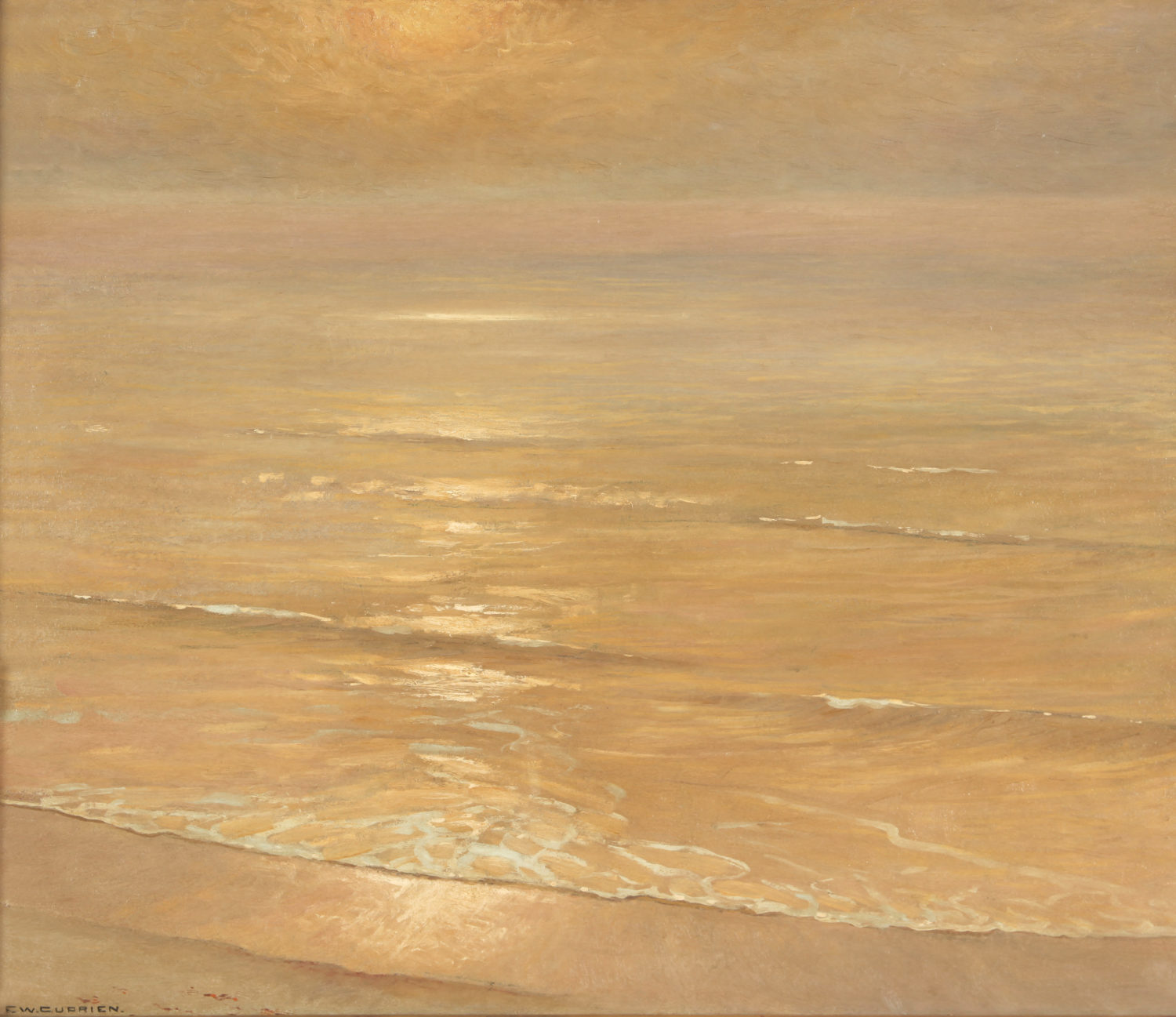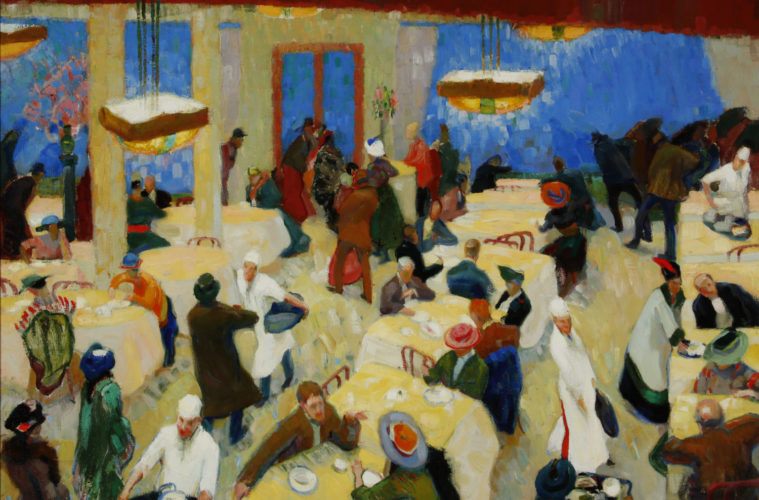As UC Irvine’s Institute and Museum of California Art (IMCA) prepares for its future opening, the venue is presenting art shows at its interim gallery on Von Karman Avenue – the site of the former Irvine Museum.
Drawing on selections from IMCA’s 1,300-piece collection of Impressionist work, which was actually gifted to the venue from the Irvine Museum in 2016, along with loans of several other paintings, “Radiant Impressions” reflects our state’s century-plus passion for depicting light, both natural and artificial, in art.

Joseph Kleitsch, “The Old Post Office”, 1922-23, oil on canvas. Laguna Art Museum
As Jean Stern, exhibition curator and former Irvine Museum Executive Director, explains in the wall text, the artists “have engaged with light not only for its optical qualities but also for its power to infuse ephemeral moments with meaning and emotion. Whether the warm golden tones of the California sun or the intense glow of electric bulbs, light in these paintings communicates a sense of anticipation, celebration, rest, and reflection.”
The show recalls previous Irvine Museum exhibitions with its inclusion of early to mid-20th century art, specifically California Impressionism and California Scene Paintings. Yet this newest iteration is enhanced by IMCA’s mission to present “creative output forged by the state’s distinct features, history, peoples, and natural environments,” according to its website; as the exhibition contains historical portraits, domestic settings, expansive outdoor scenes and images of the magnificent California environment.
Viewing the show from this perspective, along with its emphasis on light, the painting, “The Old Post Office” (1922-23) by Joseph Kleitsch on loan from Laguna Art Museum, reveals bright daylight illuminating an old-fashioned building with a cowboy and dog on its steps, as well as the foliage and canyon in the background.
The contrasting “Laguna Eucalyptus” (1917) by Guy Rose illustrates a grove of windswept trees against a clear blue sky, punctuated by puffy white clouds. The native California artist experimented with innovative methods of using light, color, and brushwork, while studying art in this state, and later in Giverny, France – where was inspired by Impressionist Claude Monet.

Guy Rose, “Laguna Eucalyptus”, c. 1917, oil on canvas. The Irvine Museum Collection at the University of California, Irvine
Another vibrant painting from this era is “Intramovement” (1918) by Edouard Vysekal, on loan from the Hilbert Collection. The work visually describes the busy interior of the Boos Brothers Cafeteria in downtown Los Angeles, with numerous waiters and customers working and engaging with others. Along with the California Scene Painting theme and expert craftsmanship, the artist infuses ambient SoCal light into the scene through large rear windows and reflects that light onto the restaurant’s interior.

Phil Paradise, “Ice Cream Vendor”, 1935, Watercolor.
The Hilbert Collection
Also from the Hilbert Collection, “Ice Cream Vendor” (1935) by Phil Paradise reveals influences from the Mexican muralism movement, particularly work by Diego Rivera. The subject matter is a scene from everyday life, of a sombrero-donned vendor, and dark-haired children, while the style includes repetition, simplification and influences from cubism.
The oldest painting in the show, “Mid-Winter, Coronado Beach” (circa 1907) by Louis Betts, depicts a classic early 20th century beach scene, featuring fancily dressed ladies adorned with hats and flowing skirts, while holding parasols, men in semi-revealing swimming attire, and well-dressed children playing on the sand; as the sand, surf and sky gleam brightly from the California sunshine.
The contrasting “Bus Stop” (1949) by Elsie Palmer Payne portrays an African American woman waiting for a bus in downtown Los Angeles. While her circumspect gaze dominates the painting, the background with urban residents and mid-century buildings is infused with California light. Burr Singer’s “Touch Up” (1943), also illustrating a young African American woman in 1940s Los Angeles, is a departure in subject matter from most other paintings of that time. Set indoors in a nightclub, the artificial light illuminates the young woman’s features.

Elsie Palmer Payne, “Bus Stop”, 1949, oil on canvas. The Buck Collection at the UCI Institute and Museum of California Art
Another modernist painting in this show is Emil Kosa’s “Freeway Beginning” (circa 1948) of an unfinished freeway in Los Angeles. It heralds the beginning of massive urban development following World War II, while overshadowing the Victorian-style Bunker Hill neighborhood in the background. (Those classic buildings were soon after torn down to the dismay of many.) As with several other paintings in this exhibition, the sweep of the land and the massive freeway in progress are bathed in vivid Southern California light.
The most luminous painting in this exhibition is Frank Cuprien’s “The Golden Hour” (1923), also on loan from Laguna Art Museum, and one of that museum’s most beloved artworks. Depicting the ocean’s low tide, lit by the afternoon’s golden glow, it is the visual equivalent of an Impressionist piece of music. Indeed, the artist was also a musician.
In its overall ambiance, “Radiant Impressions” recalls a time when rapid changes in the world were balanced by enjoyment in life, hope and reflection.
“Radiant Impressions” is on view through August 14. Institute and Museum of California Art.,18881 Von Karman Avenue, Suite 100, Irvine. Tue.–Sat., 10 am–4 pm. 949-476-0294. Free. [email protected].

Frank Cuprien, “The Golden Hour”, Laguna Beach, c. 1923, oil on board. Laguna Art Museum
Advertising disclosure: We may receive compensation for some of the links in our stories. Thank you for supporting Irvine Weekly and our advertisers.

